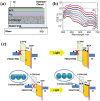Recent Progress in Organic Photodetectors and their Applications
- PMID: 33437578
- PMCID: PMC7788634
- DOI: 10.1002/advs.202002418
Recent Progress in Organic Photodetectors and their Applications
Abstract
Organic photodetectors (OPDs) have attracted continuous attention due to their outstanding advantages, such as tunability of detecting wavelength, low-cost manufacturing, compatibility with lightweight and flexible devices, as well as ease of processing. Enormous efforts on performance improvement and application of OPDs have been devoted in the past decades. In this Review, recent advances in device architectures and operation mechanisms of phototransistor, photoconductor, and photodiode based OPDs are reviewed with a focus on the strategies aiming at performance improvement. The application of OPDs in spectrally selective detection, wearable devices, and integrated optoelectronics are also discussed. Furthermore, some future prospects on the research challenges and new opportunities of OPDs are covered.
Keywords: detection; flexibility; integrated optoelectronics; organic photodetectors; photomultiplication effect.
© 2020 The Authors. Published by Wiley‐VCH GmbH.
Conflict of interest statement
The authors declare no conflict of interest.
Figures
















References
-
- Lin Q., Armin A., Burn P. L., Meredith P., Nat. Photonics 2015, 9, 687.
-
- Li Q., Guo Y., Liu Y., Chem. Mater. 2019, 31, 6359.
-
- Xie C., Lu X.‐T., Tong X.‐W., Zhang Z.‐X., Liang F.‐X., Liang L., Luo L.‐B., Wu Y.‐C., Adv. Funct. Mater. 2019, 29, 1806006.
-
- Bao C., Yang J., Bai S., Xu W., Yan Z., Xu Q., Liu J., Zhang W., Gao F., Adv. Mater. 2018, 30, 1803422. - PubMed
-
- Biswas B., Saha B., Phys. Rev. Mater. 2019, 3, 020301.
Publication types
LinkOut - more resources
Full Text Sources
Miscellaneous
